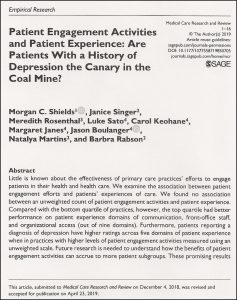MHQP’s Unique Data Sets Enable First-Time Look at Link Between Patient Engagement Activities and Patient Experience
(August 2019)
 “To our knowledge, this is the first study of its kind to examine the relationship between patient engagement activities and patients’ reported experience of care,” say the authors of Patient Engagement Activities and Patient Experience: Are Patients With a History of Depression the Canary in the Coal Mine?, an article recently published in the Medical Care Research and Review journal by Morgan C. Shields, MHQP consultant Janice Singer, MHQP former Board Chair Meredith Rosenthal, Luke Sato, Carol Keohane, Margaret Janes, Jason Boulanger, MHQP staff member Natalya Martins, and MHQP President and CEO Barbra Rabson.
“To our knowledge, this is the first study of its kind to examine the relationship between patient engagement activities and patients’ reported experience of care,” say the authors of Patient Engagement Activities and Patient Experience: Are Patients With a History of Depression the Canary in the Coal Mine?, an article recently published in the Medical Care Research and Review journal by Morgan C. Shields, MHQP consultant Janice Singer, MHQP former Board Chair Meredith Rosenthal, Luke Sato, Carol Keohane, Margaret Janes, Jason Boulanger, MHQP staff member Natalya Martins, and MHQP President and CEO Barbra Rabson.
The study seeks to begin to answer this question: to what extent do patient engagement activities in primary care result in an uptick in positive patient experience?
Why is this question important?
Increasingly, primary care practices are investing in patient engagement activities (such as “the use of patient portals, capability of storing patients’ care plans within the electronic health record, training of providers in shared decision making, availability of decision support aids, and meaningful inclusion of patients on advisory boards”) with the goal of enhancing patient care and improving outcomes.
Practices are committing to these activities because, as the authors point out, “research on patient engagement as a target of intervention has demonstrated its association with improved outcomes, increased patient safety, and reduced costs, pointing to its potential importance as a central feature of quality.”
“It is reasonable to expect that patient engagement and patient experience are connected,” say the authors. “Structures and activities to promote patient engagement at the provider level should theoretically lead to better patient experiences and then, ideally, improved outcomes through co-production of health.”
“Primary care practices need to know if these activities are having an impact on their patients,” says lead author Morgan Shields. “So we dug deep to see if there is relationship, especially among some subgroups that we hypothesized would most benefit from these activities – specifically, people with chronic conditions.”
How did MHQP’s unique data sets enable this research?
MHQP is in the unique position of having both sets of data necessary to test the connection between patient engagement and patient experience are connected at the patient level:
- MHQP, along with the Risk Management Foundation of the Harvard Medical Institutions Incorporated (CRICO/RMF), conducted the first-ever statewide survey of patient engagement practices in primary care among primary care practices in Massachusetts in 2017.
- MHQP also conducts an annual survey of patients’ experience of primary care within the state.
“The combination of these two surveys at the practice and patient level provided a unique opportunity to examine the relationship between patient engagement activities and patient experience,” says MHQP’s former Board Chair Meredith Rosenthal. “We were fortunate to be in the position to enable this groundbreaking research and begin to answer these important questions.”
“What’s especially great is that the patient engagement activities measure was vetted through MHQP’s consumer and physician stakeholder groups,” says Morgan. “This was extremely important because patient engagement happens at many different levels, so this increased our confidence in the measure.”
How was the research conducted?
In short, by using a “series of main effect and interacted multivariable logistic regression models, clustering on practice,” the authors examined the relationship between (a) a patient’s own reported experience of care and (b) the level of patient engagement activities at the primary care practice where that patient receives care.
The authors explored this relationship in three groupings:
- For all patients for whom data was available;
- For patients in the highest and lowest quartile performance for patient engagement activities; and
- For patients who self-reported a history of depression or other chronic health conditions.
What were the findings?
While the research did not find a “continuous relationship” between number of patient engagement activities and patient experience across the entire population studied, the authors did find a continuous relationship specifically for patients with a history of depression.
“It was not surprising that there was no correlation with the whole population of patients because we wouldn’t necessarily expect patient engagement activities to have an effect on all patients within a primary care practice,” says Morgan. “Patients who do not have a condition that needs to be managed may not even be exposed to the engagement activities. That’s why we wanted to focus in on the subgroups of those who have chronic health conditions.”
For patients with a history of depression, there was a “lock-step correlation,” she says. “A unit increase in patient engagement activities was associated with a unit increase in patient experience.”
What’s the meaning of all this?
As the title of the article suggests, the authors believe patients with a history of depression may be “the canary in the coal mine.” Like the canary that miners carry into mine tunnels because of their sensitivity to detecting the presence of a poisonous gas, patients with depression may be the first to notice patient engagement activities because they are “picking up, they’re more sensitive, they are detecting these engagement activities and appreciating them more so than others,” according to Morgan.
“And these efforts are somewhat new,” she says. “They’re being implemented with different degrees of fidelity and robustness in different primary care settings. So perhaps in a few years when the implementation is more robust and the practices have time to learn from the activities, then maybe other patients will detect and benefit from these activities.”
What’s next?
The authors encourage additional research to “understand how the benefits of patient engagement activities can accrue to more patient subgroups.”
MHQP stands ready to help. “MHQP has a long track record of working to improve patient experience and patient engagement,” says MHQP President and CEO Barbra Rabson. “We are pleased to have played a part in this critical area of research and excited to continue this leadership position in the future.”
The paper can be accessed via subscription at: https://journals.sagepub.com/doi/abs/10.1177/1077558719850705
If you’d like to receive a PDF copy of the article, please email Natalya Martins at nmartins@mhqp.org.
